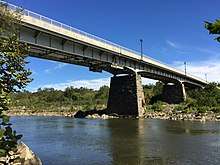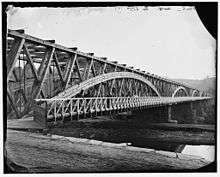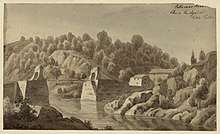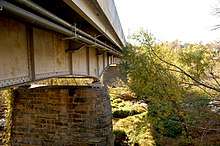Chain Bridge (Potomac River)
The Chain Bridge is a viaduct which crosses the Potomac River at Little Falls in Washington, D.C.. The steel girder bridge carries close to 22,000 cars a day.[2] It connects Washington with affluent sections of Arlington and Fairfax counties in Virginia. On the Washington side, the bridge connects with Canal Road. Left turns onto the Clara Barton Parkway from the Chain Bridge are prohibited, but the reverse is permitted. On the Virginia side, the bridge connects with State Route 123 (Chain Bridge Road), which provides access to the George Washington Memorial Parkway.
Chain Bridge | |
|---|---|
 The Chain Bridge viewed from just to the south in Arlington. Washington D.C. is on the distant shore. | |
| Coordinates | 38°55′48″N 77°06′52″W |
| Crosses | Potomac River |
| Locale | Washington, D.C. |
| Characteristics | |
| Design | Girder |
| Material | Steel |
| History | |
| Construction end | June 17, 1938[1] |
%26groups%3D_950bedfeedfb217c113fb0dad02c94548fde9794.svg)
| |
The Chain Bridge has three lanes (of which the center is reversible) and can be safely accessed by pedestrians and cyclists. The pedestrian sidewalk provides access to the Chesapeake and Ohio Canal towpath via a ramp. The bridge also carries water mains which provides Arlington County with water from the Washington Aqueduct.
History



The first bridge at the location was opened on July 3, 1797. It was a wooden covered bridge, and rotted and collapsed in 1804.[3][4] The second bridge, of similar type, burned six months after it was built.[3]
The third bridge was built four years later in 1808, and its method of construction gave subsequent iterations their names. It was a chain suspension bridge, using 1¼ inch bars. It was designed by Judge James E. Finley, and was 136 feet long by 15 feet wide.[4] It was destroyed by flood in 1810 or 1812.[3][4] The fourth bridge was also a chain suspension bridge, and though damaged by floods in 1815, it lasted until 1840.[3] The fifth bridge was built in 1840, and made of chain and wood.[3] This span collapsed in 1852.
It was replaced by a crossbeam truss structure that resembled a long garden arbor or pergola, but retained its historical name. During the American Civil War, the Chain Bridge was a popular place for the Union Army to access the countryside encampments from Fairfax County. The bridge is the site of the first Union Army Balloon Corps balloon crossing, which took place overnight on October 12, 1861, conducted by Professor Thaddeus S. C. Lowe and a band of handlers who had to precariously traverse the outsides of the fully trellised bridge. In a nine-hour ordeal, the balloon Union was fully inflated in Washington and walked out to the battlefield at Lewinsville, Virginia.[3]
The truss bridge was swept away in an 1870 flood, and a lightweight iron truss replacement was erected in 1872–1874. Traffic restrictions were placed on the bridge in the 1920s, and it was fully closed following the record flood of 1936.[3]
The eighth and present version of the bridge is a continuous steel girder structure, completed in 1938 on piers dating from the 1870s.[3]
In 1982, the bridge was significantly overhauled. The overhaul widened the three 10-foot wide lanes with a 12 foot wide one and two 11 foot ones. It also replaced a set of stairs from the bridge to the C&O Trail with a ramp, removed the sidewalk on the downstream side, added a crash barrier between the sidewalk and roadway, replaced the old railing with a fence and replaced heavy concrete with a lighter type that allowed the bridge to hold more weight.[5]
Photo gallery
 Chain Bridge, 1839
Chain Bridge, 1839 Chain Bridge during Civil War
Chain Bridge during Civil War Chain Bridge during Civil War
Chain Bridge during Civil War Chain Bridge during Civil War
Chain Bridge during Civil War.jpg) Chain Bridge, circa 1920-1924
Chain Bridge, circa 1920-1924 Underside of Chain Bridge, 2005
Underside of Chain Bridge, 2005 Chain Bridge from upstream, 2005
Chain Bridge from upstream, 2005 Chain Bridge over Chesapeake and Ohio Canal, circa 2013
Chain Bridge over Chesapeake and Ohio Canal, circa 2013
References
- Cramer, Robert (18 June 1938). "New Chain Bridge Dedicated With Address of Senator Glass". The Washington Post.
- "Archived copy". Archived from the original on 2010-07-23. Retrieved 2010-07-17.CS1 maint: archived copy as title (link)
- "History of the Chain Bridge". Johns Hopkins University Press. Archived from the original on 2005-04-02.
- Kapsch, Robert J. (2004). Canals, Volume 1. W.W. Norton & Company. ISBN 978-0-393-73088-3.
- Marks, Mary (8 September 1982). "Overhaul Of Chain Bridge Nearing Completion". The Washington Post.
External links
| Wikimedia Commons has media related to Chain Bridge (Potomac River). |
- Where Are The Chains On Chain Bridge?
- History of the Chain Bridge, from the Johns Hopkins University Press
- "Chain Bridge". Geographic Names Information System. United States Geological Survey. Retrieved 2013-01-19.